Controllable Fabrication of Zn2+ Self-Doped TiO2 Tubular Nanocomposite for Highly Efficient Water Treatment
Abstract
1. Introduction
2. Results and Discussion
Materials Characterization
3. Adsorption and Photocatalytic Performance
3.1. Adsorption Study
3.2. Photocatalytic Study
3.3. Effect of Radical Scavenger
3.4. Stability and Reusability
3.5. Photocatalytic Mechanism
4. Experimental
4.1. Materials
4.2. Preparation of Tubular Titanate (TNTs)
4.3. Preparation of Zn (II)-Doped Tubular Titanate (Zn-TNTs)
4.4. Characterization
4.5. Photocatalytic Performance
5. Conclusions
Author Contributions
Funding
Institutional Review Board Statement
Informed Consent Statement
Data Availability Statement
Conflicts of Interest
Sample Availability
References
- Carp, O.; Huisman, C.L.; Reller, A. Photoinduced reactivity of titanium dioxide. Prog. Solid State Chem. 2004, 32, 33–177. [Google Scholar] [CrossRef]
- Chen, X.; Mao, S.S. Titanium dioxide nanomaterials: Synthesis, properties, modifications, and applications. Chem. Rev. 2007, 107, 2891–2959. [Google Scholar] [CrossRef]
- Diebold, U. The surface science of titanium dioxide. Surf. Sci. Rep. 2003, 48, 53–229. [Google Scholar] [CrossRef]
- Mao, Y.; Wong, S.S. Size-and shape-dependent transformation of nanosized titanate into analogous anatase titania nanostructures. J. Am. Chem. Soc. 2006, 128, 8217–8226. [Google Scholar] [CrossRef]
- Hanaor, D.A.; Sorell, C.C. Review of the anatase to rutile phase transformation. J. Mater. Sci. 2011, 46, 855–874. [Google Scholar] [CrossRef]
- Ohno, T.; Sarukawa, K.; Matsumura, M. Crystal faces of rutile and anatase TiO2 particles and their roles in photocatalytic reactions. New J. Chem. 2002, 26, 1167–1170. [Google Scholar] [CrossRef]
- Dozzi, M.V.; Selli, E. Doping TiO2 with p-block elements: Effects on photocatalytic activity. J. Photochem. Photobiol. C 2013, 14, 13–28. [Google Scholar] [CrossRef]
- Rao, C.N.R.; Govindaraj, A. Synthesis of inorganic nanotubes. Adv. Mater. 2009, 21, 4208–4233. [Google Scholar] [CrossRef]
- Hochbaum, A.I.; Chen, R.; Delgado, R.D.; Liang, W.; Garnett, E.C.; Najarian, M.; Majumdar, A.; Yang, P. Enhanced thermoelectric performance of rough silicon nanowires. Nature 2008, 451, 163–167. [Google Scholar] [CrossRef] [PubMed]
- Huynh, W.U.; Dittmer, J.J.; Alivisatos, A.P. Hybrid Nanorod-Polymer Solar Cells. Science 2002, 295, 2425–2427. [Google Scholar] [CrossRef] [PubMed]
- Wu, D.; Liu, J.; Zhao, X.; Li, A.; Chen, Y.; Ming, N. Sequence of Events for the Formation of Titanate Nanotubes, Nanofibers, Nanowires, and Nanobelts. Chem. Mater. 2006, 18, 547–553. [Google Scholar] [CrossRef]
- Tian, B.; Zheng, X.; Kempa, T.J.; Fang, Y.; Yu, N.; Yu, G.; Huang, J.; Lieber, C.M. Coaxial silicon nanowires as solar cells and nanoelectronic power sources. Nature 2007, 449, 885–889. [Google Scholar] [CrossRef] [PubMed]
- Gautam, U.K.; Fang, X.; Bando, Y.; Zhan, J.; Golberg, D. Synthesis, structure, and multiply enhanced field-emission properties of branched ZnS nanotube– in nanowire core– shell heterostructures. ACS Nano 2008, 2, 1015–1021. [Google Scholar] [CrossRef]
- Chen, X.; Shen, S.; Guo, L.; Mao, S.S. Semiconductor-based photocatalytic hydrogen generation. Chem. Rev. 2010, 110, 6503–6570. [Google Scholar] [CrossRef] [PubMed]
- McPhililips, J.; Murphy, A.; Jonsson, M.P.; Hendren, W.R.; Atkinson, R.; Hook, F.; Zayats, A.V.; Pollard, R.J. High-performance biosensing using arrays of plasmonic nanotubes. ACS Nano 2010, 4, 2210–2216. [Google Scholar] [CrossRef]
- Wang, J.; Gudiksen, M.S.; Duan, X.; Cui, Y.; Lieber, C.M. Highly polarized photoluminescence and photodetection from single indium phosphide nanowires. Science 2001, 293, 1455–1457. [Google Scholar] [CrossRef]
- Mor, G.K.; Varghese, O.K.; Paulose, M.; Shankar, K.; Grimes, C.A. A review on highly ordered, vertically oriented TiO2 nanotube arrays: Fabrication, material properties, and solar energy applications. Sol. Energy Mater. Sol. Cells 2006, 90, 2011–2075. [Google Scholar] [CrossRef]
- Wang, Z.L. Splendid one-dimensional nanostructures of zinc oxide: A new nanomaterial family for nanotechnology. ACS Nano 2008, 2, 1987–1992. [Google Scholar] [CrossRef]
- Luévano-Hipólito, E.; Quintero-Lizárraga, O.L.; Torres-Martínez, L.M. A Critical Review of the Use of Bismuth Halide Perovskites for CO2 Photoreduction: Stability Challenges and Strategies Implemented. Catalysts 2022, 12, 1410. [Google Scholar] [CrossRef]
- Luévano-Hipólito, E.; Torres-Alvarez, D.A.; Torres-Martínez, L.M. Flexible BiOI thin films photocatalysts toward renewable solar fuels production. J. Environ. Chem. Eng. 2023, 11, 109557. [Google Scholar] [CrossRef]
- Zhang, Y.; Tang, Z.R.; Fu, X.; Xu, Y.J. TiO2−Graphene nanocomposites for gas-phase photocatalytic degradation of volatile aromatic pollutant: Is TiO2–Graphene truly different from other TiO2–Carbon composite materials? ACS Nano 2010, 4, 7303–7314. [Google Scholar] [CrossRef] [PubMed]
- Zhang, N.; Liu, S.; Fu, X.; Xu, Y.J. Synthesis of M@ TiO2 (M= Au, Pd, Pt) core–shell nanocomposites with tunable photoreactivity. Phys. Chem. C 2011, 115, 9136–9145. [Google Scholar] [CrossRef]
- Xu, Y.J.; Zhuang, Y.; Fu, X. New insight for enhanced photocatalytic activity of TiO2 by doping carbon nanotubes: A case study on degradation of benzene and methyl orange. J. Phys. Chem. C 2010, 114, 2669–2676. [Google Scholar] [CrossRef]
- Zhang, Y.; Tang, Z.R.; Fu, X.; Xu, Y.J. Nanocomposite of Ag–AgBr–TiO2 as a photoactive and durable catalyst for degradation of volatile organic compounds in the gas phase. Appl. Catal. B 2011, 106, 445–452. [Google Scholar] [CrossRef]
- Kiatkittipong, K.; Scott, J.; Amal, R. Hydrothermally synthesized titanate nanostructures: Impact of heat treatment on particle characteristics and photocatalytic properties. ACS Appl. Mater. Interfaces 2011, 3, 3988–3996. [Google Scholar] [CrossRef] [PubMed]
- Yu, J.; Yu, H.; Cheng, B.; Trapalis, C.J. Effects of calcination temperature on the microstructures and photocatalytic activity of titanate nanotubes. Mol. Catal. A 2006, 249, 135–142. [Google Scholar] [CrossRef]
- Lee, C.K.; Wang, C.C.; Lyn, M.D.; Juang, L.C.; Liu, S.S.; Hung, S.H. Effects of sodium content and calcination temperature on the morphology, structure and photocatalytic activity of nanotubular titanates. J. Colloid Interface Sci. 2007, 316, 562–569. [Google Scholar] [CrossRef]
- Peng, C.-W.; Richard-Plouet, M.; Ke, T.-Y.; Lee, C.-Y.; Chiu, H.-T.; Marhic, C.; Puzenat, E.; Lemoigno, F.; Brohan, L. Chimie douce route to sodium hydroxo titanate nanowires with modulated structure and conversion to highly photoactive titanium dioxides. Chem. Mater. 2008, 20, 7228–7236. [Google Scholar] [CrossRef]
- Umek, P.; Pregelj, M.; Gloter, A.; Cevc, P.; Jagličić, Z.; Čeh, M.; Pirnat, U.; Arčon, D. Coordination of intercalated Cu2+ sites in copper doped sodium titanate nanotubes and nanoribbons. J. Phys. Chem. C 2008, 112, 15311–15319. [Google Scholar] [CrossRef]
- Santara, B.; Giri, P.K.; Dhara, S.; Imakita, K.; Fujii, M. Microscopic origin of lattice contraction and expansion in undoped rutile TiO2 nanostructures. J. Phys. D Appl. Phys. 2014, 47, 215302. [Google Scholar] [CrossRef]
- Sun, X.; Li, Y. Synthesis and characterization of ion-exchangeable titanate nanotubes. Chem. Eur. J. 2003, 9, 2229–2238. [Google Scholar] [CrossRef] [PubMed]
- Umek, P.; Bittencourt, C.; Gloter, C.; Dominko, R.; Jagličić, Z.; Cevc, P.; Arčon, D. Local coordination and valence states of cobalt in sodium titanate nanoribbons. J. Phys. Chem. C 2012, 116, 11357–11363. [Google Scholar] [CrossRef]
- Arroyo, R.; Córdoba, G.; Padilla, J.; Lara, V.H. Influence of manganese ions on the anatase–rutile phase transition of TiO2 prepared by the sol–gel process. Mater. Lett. 2002, 54, 397–402. [Google Scholar] [CrossRef]
- Chang, Y.S.; Chang, Y.H.; Chen, I.G.; Chen, G.J.; Chai, Y.L. Synthesis and characterization of zinc titanate nano-crystal powders by sol–gel technique. J. Cryst. Growth 2002, 243, 319–326. [Google Scholar] [CrossRef]
- Zhang, N.; Fu, X.; Xu, Y.J. A facile and green approach to synthesize Pt@CeO2 nanocomposite with tunable core-shell and yolk-shell structure and its application as a visible light photocatalyst. J. Mater. Chem. 2011, 21, 8152–8158. [Google Scholar] [CrossRef]
- Tang, Z.R.; Li, F.; Zhang, Y.; Fu, X.; Xu, Y.J. Composites of titanate nanotube and carbon nanotube as photocatalyst with high mineralization ratio for gas-phase degradation of volatile aromatic pollutant. J. Phys. Chem. C 2011, 115, 7880–7886. [Google Scholar] [CrossRef]
- Singh, L.; Thakur, V.; Punia, R.; Kundu, R.S.; Singh, A. Structural and optical properties of barium titanate modified bismuth borate glasses. Solid State Sci. 2014, 37, 64–71. [Google Scholar] [CrossRef]
- Byeon, S.H.; Lee, S.O.; Kim, H. Structure and Raman spectra of layered titanium oxides. J. Solid State Chem. 1997, 130, 110–116. [Google Scholar] [CrossRef]
- Pan, L.; Wang, S.; Zou, J.J.; Huang, Z.F.; Wang, L.; Zhang, X. Ti3+-defected and V-doped TiO2 quantum dots loaded on MCM-41. Chem. Commun. 2014, 50, 988–990. [Google Scholar] [CrossRef]
- Xia, Y.; Jiang, Y.; Li, F.; Xia, M.; Xue, B.; Li, Y. Effect of calcined atmosphere on the photocatalytic activity of P-doped TiO2. Appl. Surf. Sci. 2014, 289, 306–315. [Google Scholar] [CrossRef]
- Alrowaili, Z.A.; Alsohaimi, I.H.; Betiha, M.A.; Essawy, A.A.; Mousa, A.A.; Alruwaili, S.F.; Hassan, H.M. Green fabrication of silver imprinted titania/silica nanospheres as robust visible light-induced photocatalytic wastewater purification. Mater. Chem. Phys. 2020, 241, 122403. [Google Scholar] [CrossRef]
- Cai, X.; Mao, L.; Fujitsuka, M.; Majima, T.; Kasani, S.; Wu, N.; Zhang, J. Effects of Bi-dopant and co-catalysts upon hole surface trapping on La2Ti2O7 nanosheet photocatalysts in overall solar water splitting. Nano Res. 2022, 15, 438–445. [Google Scholar] [CrossRef]
- Chen, J.K.; Ma, J.P.; Guo, S.Q.; Chen, Y.M.; Zhao, Q.; Zhang, B.B.; Li, Z.-Y.; Zhou, Y.; Hou, J.; Kuroiwa, Y.; et al. High-efficiency violet-emitting all-inorganic perovskite nanocrystals enabled by alkaline-earth metal passivation. Chem. Mater. 2019, 31, 3974–3983. [Google Scholar] [CrossRef]
- Zhao, L.; Wang, S.; Pan, F.; Tang, Z.; Zhang, Z.; Zhong, S.; Zhang, J. Thermal convection induced TiO2 microclews as superior electrode materials for lithium-ion batteries. J. Mater. Chem. A 2018, 6, 11688–11693. [Google Scholar] [CrossRef]
- Li, Y.; Lu, Y.; Jia, X.; Ma, Z.; Zhang, J. 2D/1D Z-scheme WO3/g-C3N4 photocatalytic heterojunction with enhanced photo-induced charge-carriers separation. J. Phys. D Appl. Phys. 2022, 55, 434005. [Google Scholar] [CrossRef]
- Lagergren, S. About the theory of so-called adsorption of soluble substance. K. Sven. Vetensk. Handl. Band 1898, 24, 1–39. [Google Scholar]
- Ho, Y.S.; McKay, G. Pseudo-second order model for sorption processes. Process. Biochem. 1999, 34, 451–465. [Google Scholar] [CrossRef]
- Raha, S.; Ahmaruzzaman, M. Facile fabrication of g-C3N4 supported Fe3O4 nanoparticles/ZnO nanorods: A superlative visible light responsive architecture for express degradation of pantoprazole. Chem. Eng. J. 2020, 387, 123766. [Google Scholar] [CrossRef]
- Jain, R.; Sikarwar, S. Removal of hazardous dye congored from waste material. J. Hazard. Mater. 2008, 152, 942–948. [Google Scholar] [CrossRef]
- Payan, A.; Fattahi, M.; Jorfi, S.; Roozbehani, B.; Payan, S. Synthesis and characterization of titanate nanotube/single-walled carbon nanotube (TNT/SWCNT) porous nanocomposite and its photocatalytic activity on 4-chlorophenol degradation under UV and solar irradiation. Appl. Surf. Sci. 2018, 434, 336–350. [Google Scholar] [CrossRef]
- Jorfi, S.; Kakavandi, B.; Motlagh, H.R.; Ahmadi, M.; Jaafarzadeh, N. A novel combination of oxidative degradation for benzotriazole removal using TiO2 loaded on FeIIFe2IIIO4@C as an efficient activator of peroxymonosulfate. Appl. Catal. B Environ. 2017, 219, 216–230. [Google Scholar] [CrossRef]
- Di Valentin, C.; Finazzi, E.; Pacchioni, G.; Selloni, A.; Livraghi, S. Fundamentals of photocatalysis on TiO2. Phys. Chem. Chem. Phys. 2011, 13, 21086–21100. [Google Scholar]
- Li, X.; Zhu, J.; Wang, C.; Yang, X.; Li, W. Dopant/defect-engineered TiO2-based photocatalysts. Chem. Soc. Rev. 2019, 48, 2108–2129. [Google Scholar]
- Wang, X.; Li, G.; Li, X.; Chen, H.; Zhang, S. Dopant engineering for photocatalysis: Advances and prospects. Energy Environ. Sci. 2018, 11, 1770–1824. [Google Scholar]
- Wu, Y.; Jiang, C.; Zhao, J.; Chen, F. Defect and doping engineering of TiO2 for photocatalytic applications. J. Mater. Chem. A 2020, 8, 3726–3745. [Google Scholar]
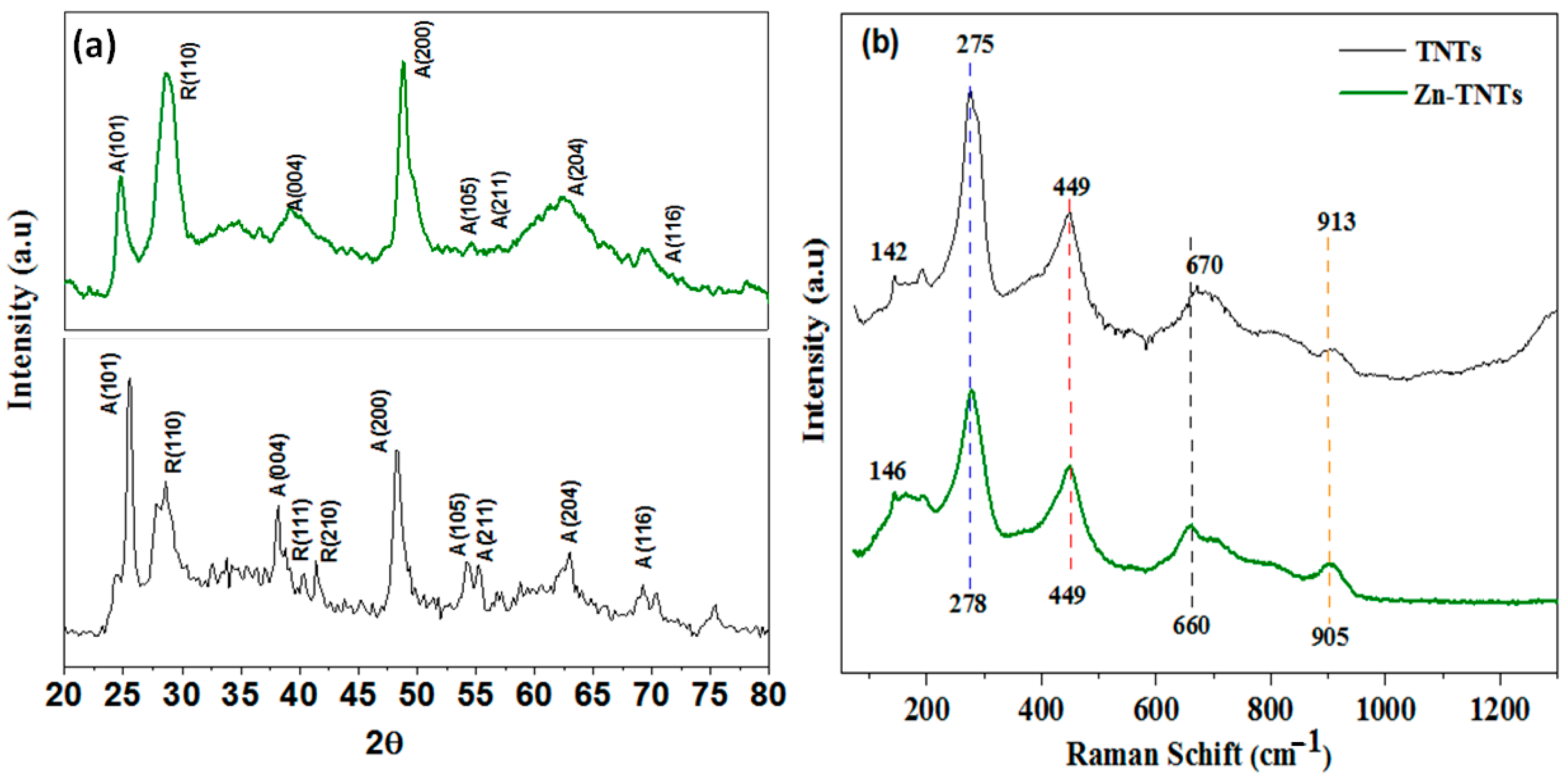
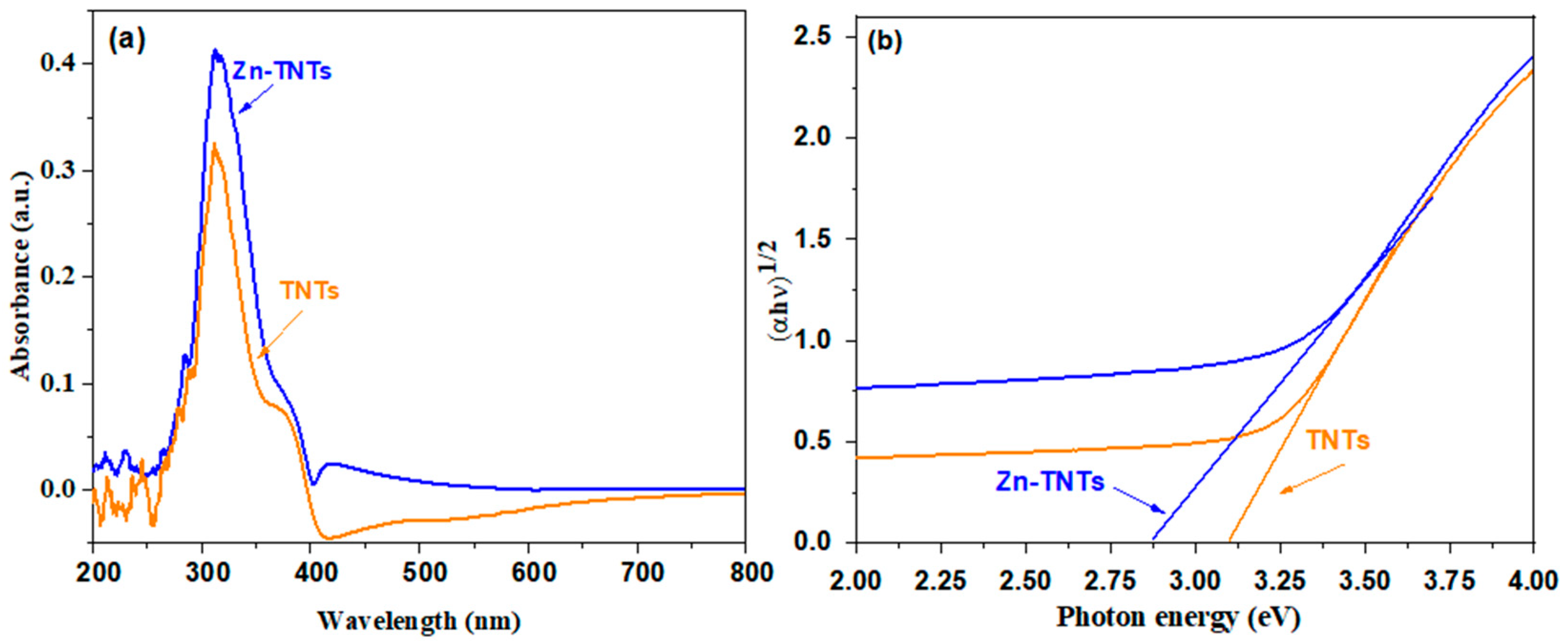
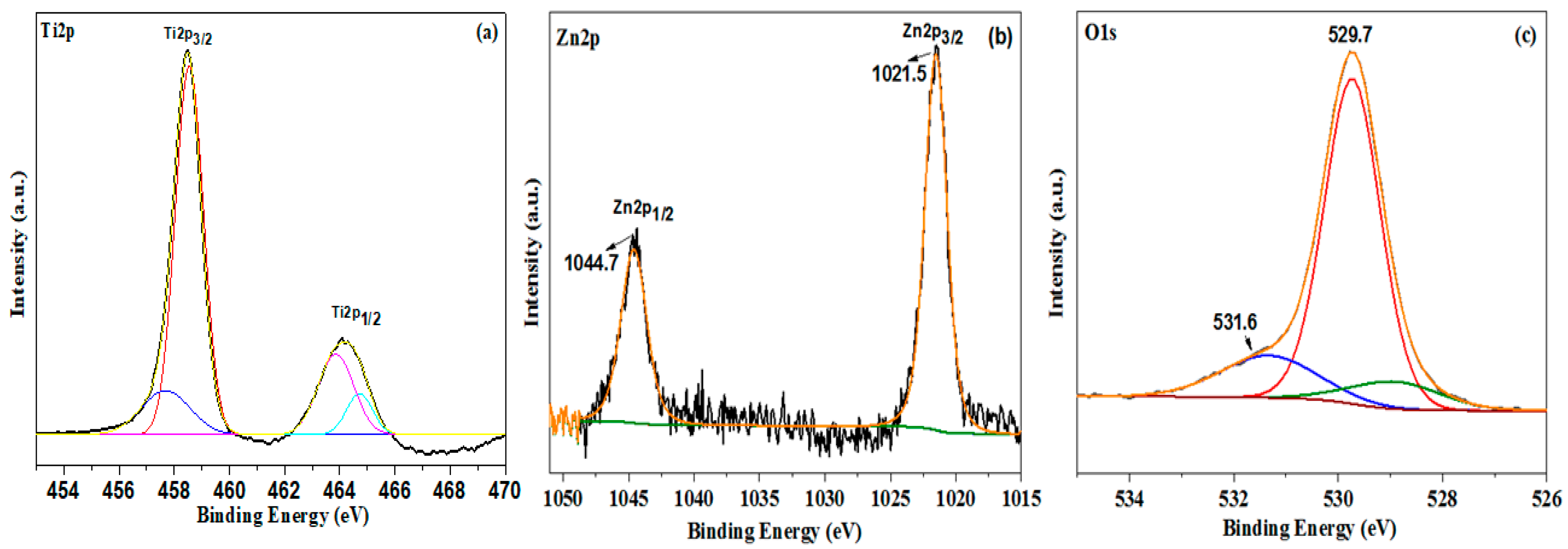

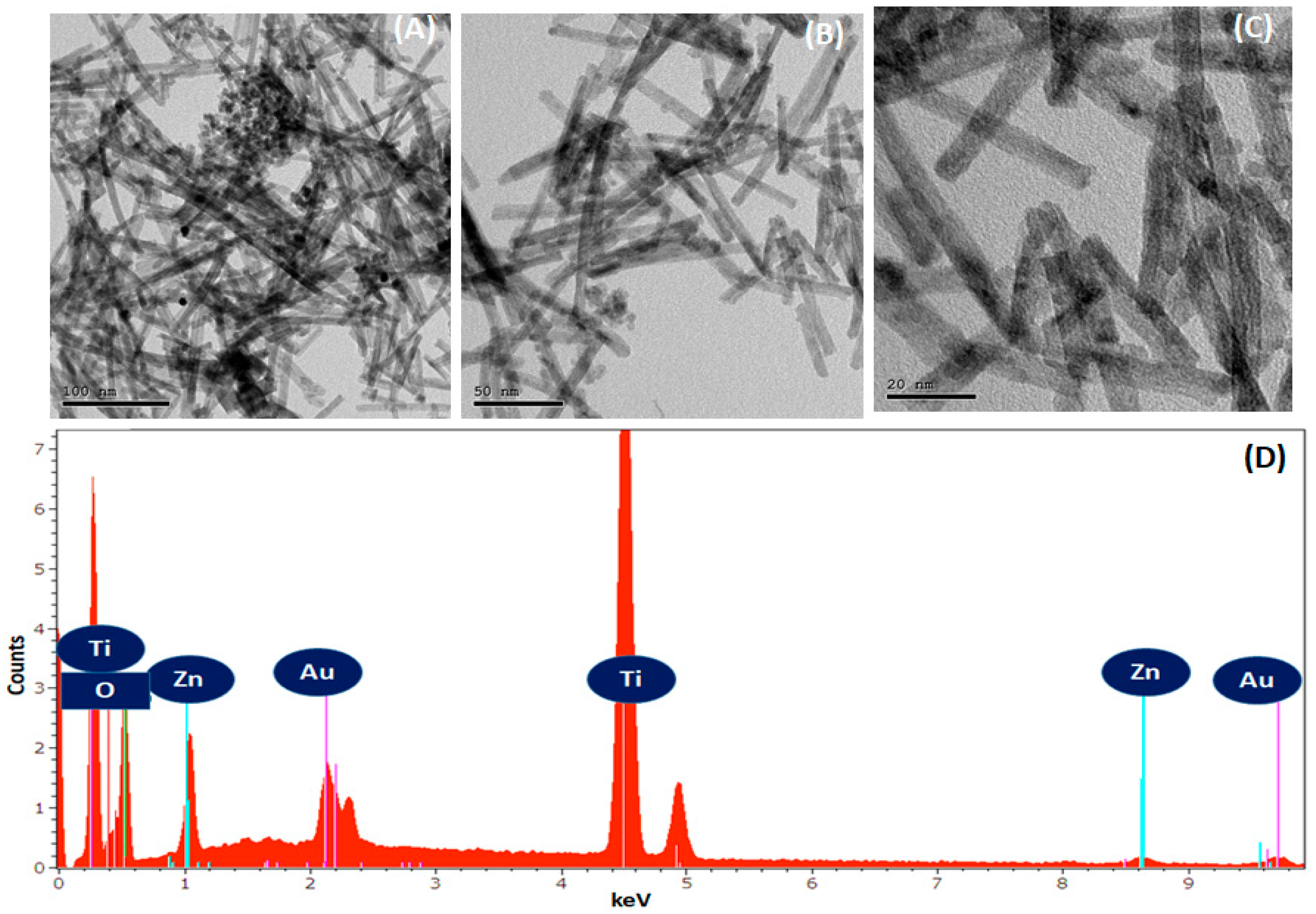
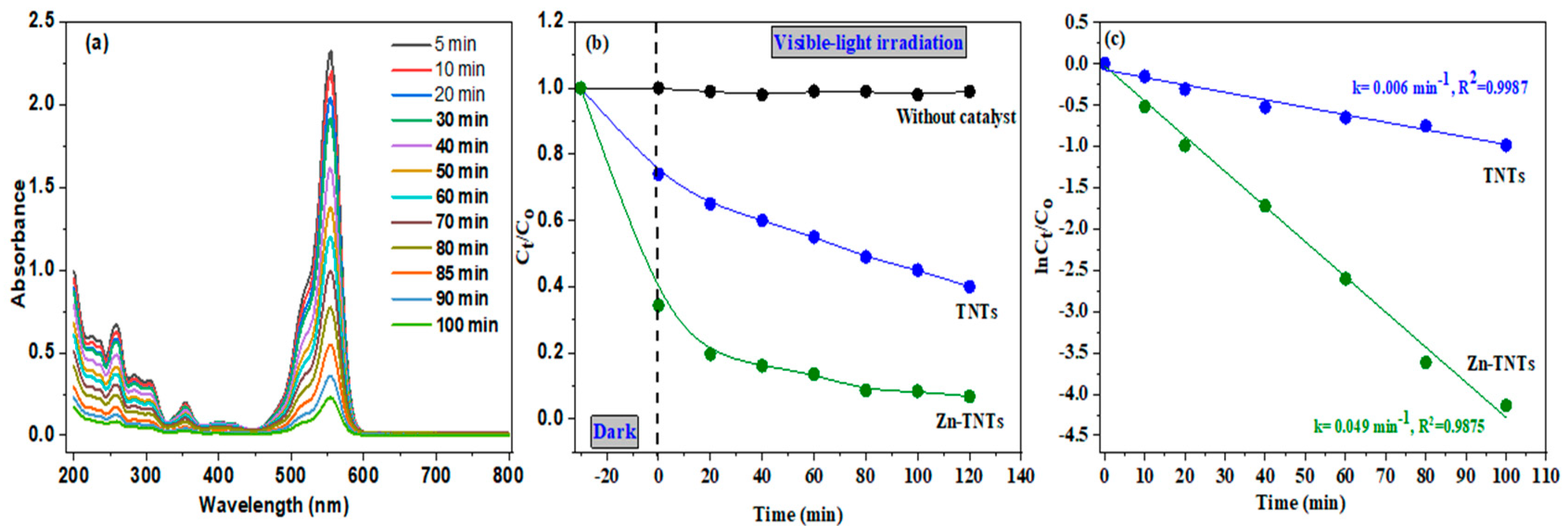
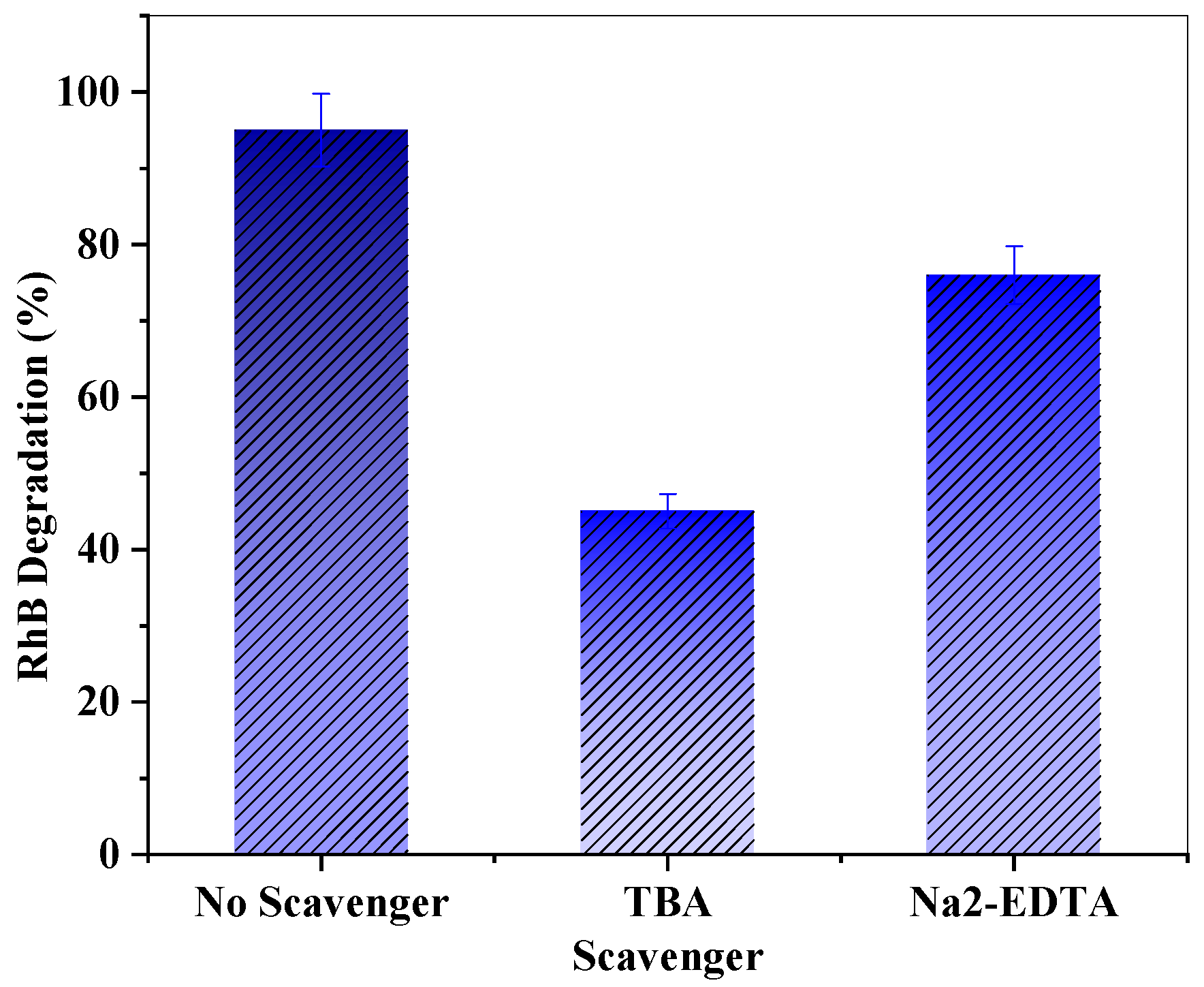

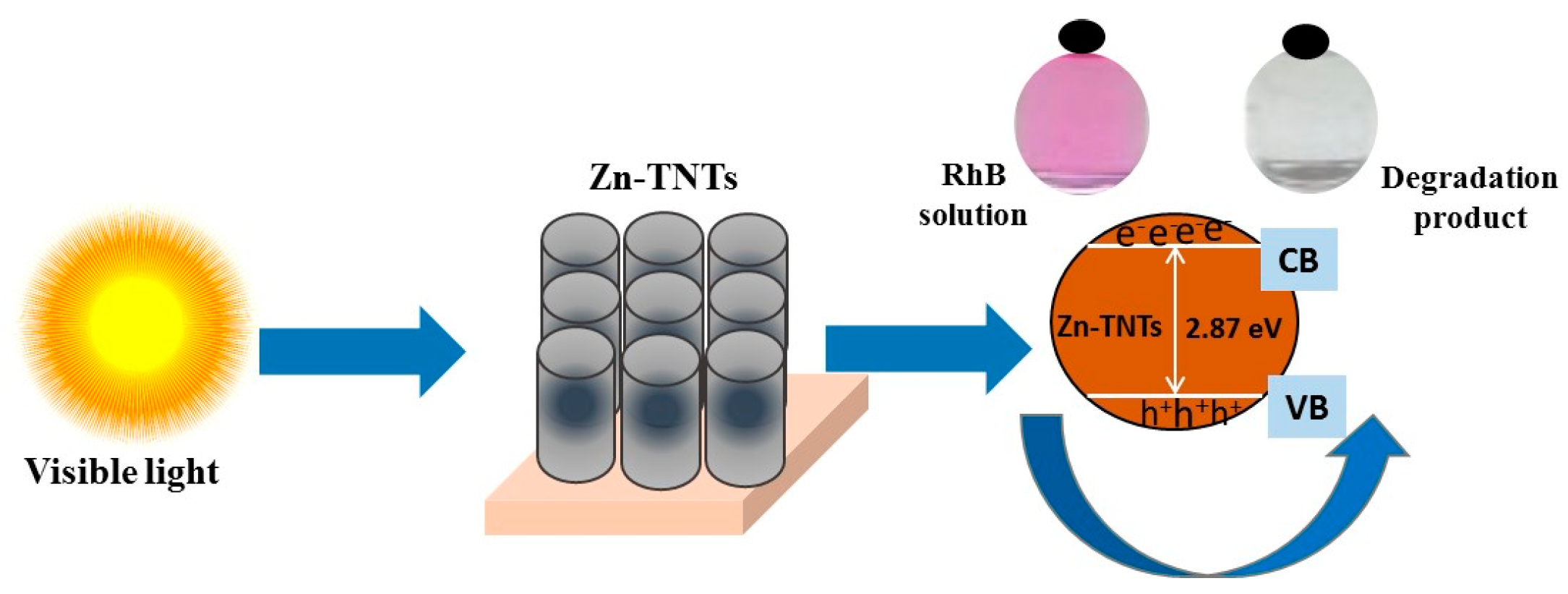
| Pseudo-First-Order | Pseudo-Second-Order | |||||
|---|---|---|---|---|---|---|
| Sample | qe1,cal. (mg/g) | K1 (1/min) | R2 | qe2,cal. (mg/g) | K2 (g/mg-min) | R2 |
| TNTs | 16.24 | 0.0110 | 0.9638 | 16.73 | 0.0103 | 0.9591 |
| Zn-TNTs | 37.35 | 0.0364 | 0.9927 | 38.34 | 0.0365 | 0.9911 |
| Sample | Langmuir Isotherm | Freundlich Isotherm | ||||
|---|---|---|---|---|---|---|
| qm,cal. | KL | R2 | KF | n | R2 | |
| (mg/g) | (L/mg) | (mg/g)(L/mg)1/n | ||||
| TNTs | 99 | 0.251 | 0.9971 | 14.1 | 0.3 | 0.9321 |
| Zn-TNTs | 146 | 0.342 | 0.9982 | 22.7 | 0.7 | 0.9732 |
| Physico-Chemical Variables | Pre-Photocatalytic Degradation | In Dark for 60 min | Post-Photocatalytic Degradation after | ||||
|---|---|---|---|---|---|---|---|
| 10 min | 20 min | 40 min | 60 min | 180 min | |||
| COD (ppm) | 28.5 | 18.1 | 14.6 | 12.1 | 8.4 | 3.1 | 1.4 |
Disclaimer/Publisher’s Note: The statements, opinions and data contained in all publications are solely those of the individual author(s) and contributor(s) and not of MDPI and/or the editor(s). MDPI and/or the editor(s) disclaim responsibility for any injury to people or property resulting from any ideas, methods, instructions or products referred to in the content. |
© 2023 by the authors. Licensee MDPI, Basel, Switzerland. This article is an open access article distributed under the terms and conditions of the Creative Commons Attribution (CC BY) license (https://creativecommons.org/licenses/by/4.0/).
Share and Cite
Hassan, H.M.A.; Alsohaimi, I.H.; Essawy, A.A.; El-Aassar, M.R.; Betiha, M.A.; Alshammari, A.H.; Mohamed, S.K. Controllable Fabrication of Zn2+ Self-Doped TiO2 Tubular Nanocomposite for Highly Efficient Water Treatment. Molecules 2023, 28, 3072. https://doi.org/10.3390/molecules28073072
Hassan HMA, Alsohaimi IH, Essawy AA, El-Aassar MR, Betiha MA, Alshammari AH, Mohamed SK. Controllable Fabrication of Zn2+ Self-Doped TiO2 Tubular Nanocomposite for Highly Efficient Water Treatment. Molecules. 2023; 28(7):3072. https://doi.org/10.3390/molecules28073072
Chicago/Turabian StyleHassan, Hassan M. A., Ibrahim H. Alsohaimi, Amr A. Essawy, Mohamed R. El-Aassar, Mohamed A. Betiha, Alhulw H. Alshammari, and Shaimaa K. Mohamed. 2023. "Controllable Fabrication of Zn2+ Self-Doped TiO2 Tubular Nanocomposite for Highly Efficient Water Treatment" Molecules 28, no. 7: 3072. https://doi.org/10.3390/molecules28073072
APA StyleHassan, H. M. A., Alsohaimi, I. H., Essawy, A. A., El-Aassar, M. R., Betiha, M. A., Alshammari, A. H., & Mohamed, S. K. (2023). Controllable Fabrication of Zn2+ Self-Doped TiO2 Tubular Nanocomposite for Highly Efficient Water Treatment. Molecules, 28(7), 3072. https://doi.org/10.3390/molecules28073072









